Gamma-tubulin is essential for microtubule organization and development in Arabidopsis
- PMID: 16698945
- PMCID: PMC1475493
- DOI: 10.1105/tpc.105.039644
Gamma-tubulin is essential for microtubule organization and development in Arabidopsis
Abstract
The process of microtubule nucleation in plant cells is still a major question in plant cell biology. gamma-Tubulin is known as one of the key molecular players for microtubule nucleation in animal and fungal cells. Here, we provide genetic evidence that in Arabidopsis thaliana, gamma-tubulin is required for the formation of spindle, phragmoplast, and cortical microtubule arrays. We used a reverse genetics approach to investigate the role of the two Arabidopsis gamma-tubulin genes in plant development and in the formation of microtubule arrays. Isolation of mutants in each gene and analysis of two combinations of gamma-tubulin double mutants showed that the two genes have redundant functions. The first combination is lethal at the gametophytic stage. Disruption of both gamma-tubulin genes causes aberrant spindle and phragmoplast structures and alters nuclear division in gametophytes. The second combination of gamma-tubulin alleles affects late seedling development, ultimately leading to lethality 3 weeks after germination. This partially viable mutant combination enabled us to follow dynamically the effects of gamma-tubulin depletion on microtubule arrays in dividing cells using a green fluorescent protein marker. These results establish the central role of gamma-tubulin in the formation and organization of microtubule arrays in Arabidopsis.
Figures
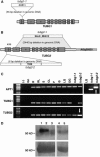
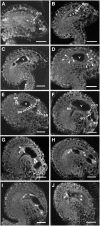

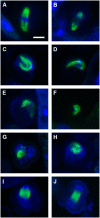
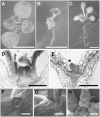


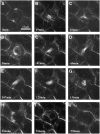
Similar articles
-
Augmin plays a critical role in organizing the spindle and phragmoplast microtubule arrays in Arabidopsis.Plant Cell. 2011 Jul;23(7):2606-18. doi: 10.1105/tpc.111.086892. Epub 2011 Jul 12. Plant Cell. 2011. PMID: 21750235 Free PMC article.
-
Helical microtubule arrays in a collection of twisting tubulin mutants of Arabidopsis thaliana.Proc Natl Acad Sci U S A. 2007 May 15;104(20):8544-9. doi: 10.1073/pnas.0701224104. Epub 2007 May 8. Proc Natl Acad Sci U S A. 2007. PMID: 17488810 Free PMC article.
-
Gamma-tubulin is essential for acentrosomal microtubule nucleation and coordination of late mitotic events in Arabidopsis.Plant Cell. 2006 May;18(5):1199-212. doi: 10.1105/tpc.105.038364. Epub 2006 Apr 7. Plant Cell. 2006. PMID: 16603653 Free PMC article.
-
Acentrosomal microtubule nucleation in higher plants.Int Rev Cytol. 2002;220:257-89. doi: 10.1016/s0074-7696(02)20008-x. Int Rev Cytol. 2002. PMID: 12224551 Review.
-
Microtubule nucleation for the assembly of acentrosomal microtubule arrays in plant cells.New Phytol. 2019 Jun;222(4):1705-1718. doi: 10.1111/nph.15705. Epub 2019 Feb 25. New Phytol. 2019. PMID: 30681146 Review.
Cited by
-
Feeding cells induced by phytoparasitic nematodes require γ-tubulin ring complex for microtubule reorganization.PLoS Pathog. 2011 Dec;7(12):e1002343. doi: 10.1371/journal.ppat.1002343. Epub 2011 Dec 1. PLoS Pathog. 2011. PMID: 22144887 Free PMC article.
-
Microtubule and katanin-dependent dynamics of microtubule nucleation complexes in the acentrosomal Arabidopsis cortical array.Nat Cell Biol. 2010 Nov;12(11):1064-70. doi: 10.1038/ncb2110. Epub 2010 Oct 10. Nat Cell Biol. 2010. PMID: 20935636
-
Cell biology of primary cell wall synthesis in plants.Plant Cell. 2022 Jan 20;34(1):103-128. doi: 10.1093/plcell/koab249. Plant Cell. 2022. PMID: 34613413 Free PMC article. Review.
-
γ-Tubulin Complexes and Fibrillar Arrays: Two Conserved High Molecular Forms with Many Cellular Functions.Cells. 2021 Apr 1;10(4):776. doi: 10.3390/cells10040776. Cells. 2021. PMID: 33915825 Free PMC article. Review.
-
Collapsed abnormal pollen1 gene encoding the Arabinokinase-like protein is involved in pollen development in rice.Plant Physiol. 2013 Jun;162(2):858-71. doi: 10.1104/pp.113.216523. Epub 2013 Apr 29. Plant Physiol. 2013. PMID: 23629836 Free PMC article.
References
-
- Alexander, M.P. (1969). Differential staining of aborted and non aborted pollen. Stain Technol. 44 117–122. - PubMed
-
- Alonso, J.M., et al. (2003). Genome-wide insertional mutagenesis of Arabidopsis thaliana. Science 301 653–657. - PubMed
-
- Arabidopsis Genome Initiative (2000). Analysis of the genome sequence of the flowering plant Arabidopsis thaliana. Nature 408 796–815. - PubMed
-
- Azimzadeh, J., Traas, J., and Pastuglia, M. (2001). Molecular aspects of microtubule dynamics in plants. Curr. Opin. Plant Biol. 4 513–519. - PubMed
Publication types
MeSH terms
Substances
LinkOut - more resources
Full Text Sources
Molecular Biology Databases

